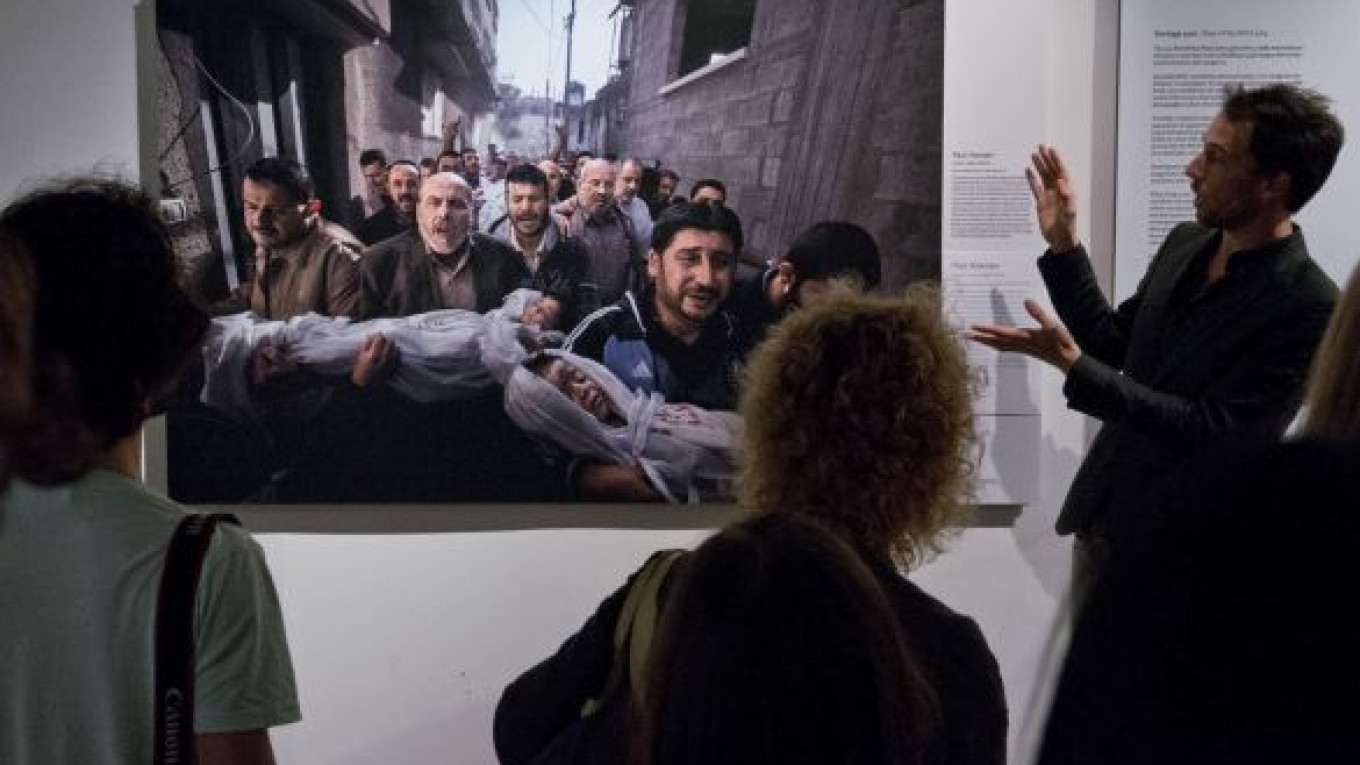The harrowing results of photojournalists’ trips to war scenes, precision action shots from bull races and olympic fencing, and portraits of both penguins and whale sharks all come together in Moscow, as part of a moving exhibition of the globe’s finest photographs.
World Press Photo 2013 is ensconcing itself in Red October Gallery until June 30, exhibiting the talents of people who provide firsthand evidence of the aforementioned scenes to a mass audience through outlets and agencies including Reuters, European Press Photo Agency, AFP, BBC and The New York Times.
The competition was held in Amsterdam in February, with the collection then traveling to Edinburgh, Tokyo, Brisbane and Belgium, remarkably restive places in comparison to the sites at which many were taken.
Winner of the “Spot News” category, Swedish photojournalist Paul Hansen documented “Gaza Burial” last November, when the Israeli-termed “Operation Pillar of Defense” scattered Gaza with rocket-fire, killing more than 150 people, including some 30 children.
His photograph depicts two men carrying their 2- and 4-year-old nephews to mosques for burial. It was taken one day prior to the ceasefire.
“I was never in fear of my life on that particular trip,” he stated, “which was probably dumb; the next day we covered another funeral of a 4-year-old girl that was killed by a rocket.”
Turkish photographer Emin Özmen won second prize in the same category, documenting a man being violently interrogated at the hands of the Free Syria Army because he was under suspicion of providing government informants with money.
He said it was often difficult to gain access to such politically charged situations. “It’s a very tough challenge,” he stated, valuing honesty in his work above all else. “I get concerned about a possible misinterpretation or false evaluation while I witness and tell people what I see.”
“By the time I was noticed, I had already taken pictures that could tell what really happened. I had to leave the interrogation room, and I did. Yet I didn’t see any negative reaction for the photographs that I took in the room, or I wasn’t threatened,” he mused.
However, the business is notoriously risky, with significant deaths from 2003 to 2009 in Iraq, Libya, Syria and Somalia. Hansen said Libya was the most dangerous, but he was still regarded as a valuable political tool “when the reason for the death and sorrow is due to political failure,” he stated.
“The problem can sometimes be reversed; people want to show too much. I was once almost dragged into a section of a morgue in Libya and told to photograph what was left of people after an explosion.”
Özmen has taken the risky step of documenting scenes in Somalia – a country which was home to 12 journalist deaths last year, according to Committee to Protect Journalists (CPJ) statistics.
“There have been photo stories I have created in Somalia, probably the world’s most risky working area,” he said. “The Somalian Civil War has been going on for 20 years; fierce clashes occur so frequently,” Özmen said, calling it a “very risky place to be.”
“And Syria, of course,” he added. “Almost 90 journalists have passed away in the last two years. It directly makes you a target to be a journalist in Syria.”
Neither Hansen or Özmen cope with the scenes they witness, stating that they “don’t” or “can’t,” simply, but firmly. ?
“I cry a lot and lose a lot of sleep over the fate of the people I meet. One way to cope is to continue to try and tell the stories of those people,” Hansen said. ?
“I think of the situations of people who I have left behind. I get concerned, yet this unfortunately doesn’t mean anything,” relented Özmen. ?
“The war never comes to an end, therefore you have to desperately watch and become a lone beholder like others.”
The impact of their photographs can be somewhat distressing, yet very powerful, and despite the inability to cope, both stick with it.
“An actor working at a hospital as a clown with cancer stricken children once told me: ‘When you are close to death, life and what’s important become very clear,’” recollected Hansen, saying that visual journalism exposes areas of life where the existence of human kind is at stake.
“We can all identify ourselves with those fundamental questions,” he said.? “I also think that in the nature of news gathering, war and crisis become dominant as issues. We simply don’t report about airplanes that land — only when they don’t.”
Özmen said the world was still witnessing bloody, armed clashes, and the practice of photographing the action was a method of questioning and attempting to seek solutions, inadvertently agreeing with Hansen over the creation of news itself.
“The tragedy happening in Syria concerns all the countries in the world — Palestine, likewise. We would have been photographing nice things if they had existed on the agenda of the world,” he concluded.
Related articles:
A Message from The Moscow Times:
Dear readers,
We are facing unprecedented challenges. Russia's Prosecutor General's Office has designated The Moscow Times as an "undesirable" organization, criminalizing our work and putting our staff at risk of prosecution. This follows our earlier unjust labeling as a "foreign agent."
These actions are direct attempts to silence independent journalism in Russia. The authorities claim our work "discredits the decisions of the Russian leadership." We see things differently: we strive to provide accurate, unbiased reporting on Russia.
We, the journalists of The Moscow Times, refuse to be silenced. But to continue our work, we need your help.
Your support, no matter how small, makes a world of difference. If you can, please support us monthly starting from just $2. It's quick to set up, and every contribution makes a significant impact.
By supporting The Moscow Times, you're defending open, independent journalism in the face of repression. Thank you for standing with us.
Remind me later.


